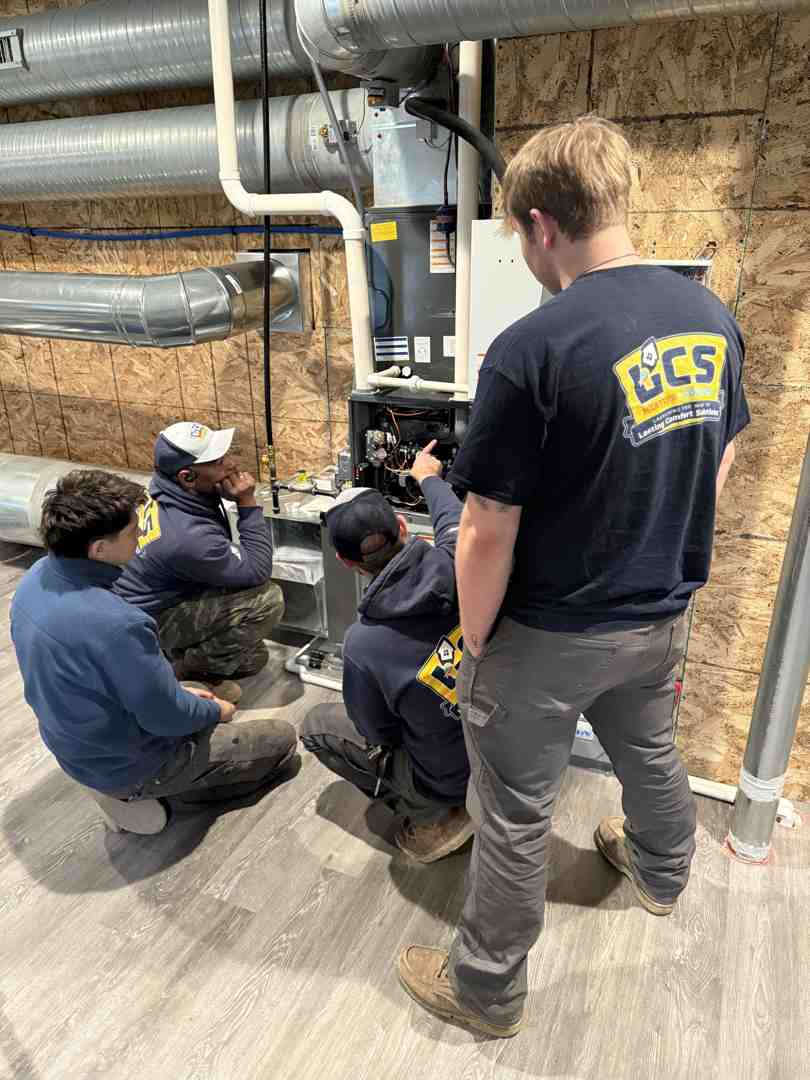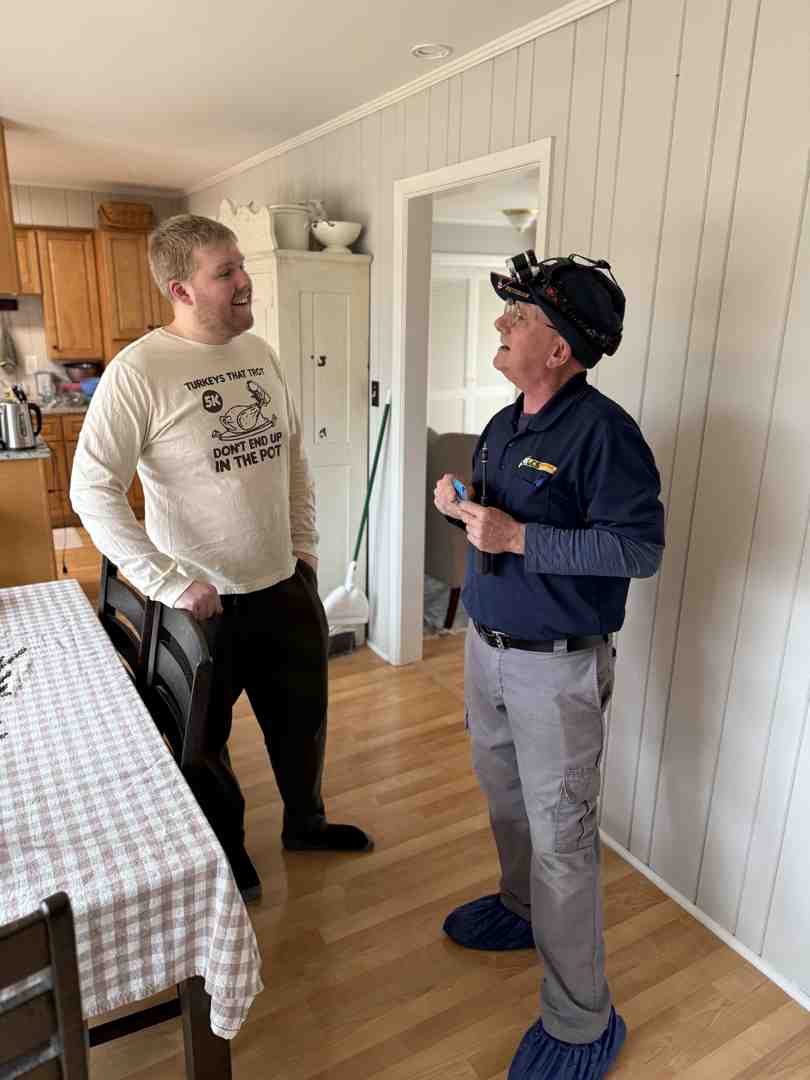Your Indoor Air Quality: Tips for a Healthier Home
The Foundation of a Healthier Home Environment
Clean air circulation is the foundation of every healthy home, yet it's something most Indianapolis homeowners rarely think about until problems arise. Simply put, it's the continuous movement of air that brings fresh oxygen in while removing stale, polluted air and moisture.
Key ways to improve clean air circulation:
- Open windows and doors on opposite sides of your home for cross-ventilation
- Use ceiling fans to distribute air evenly throughout rooms
- Run your HVAC system fan continuously instead of "auto" mode
- Keep interior doors open to prevent stagnant air pockets
- Change air filters regularly to maintain proper airflow
- Clear furniture away from vents to allow unrestricted air movement
Good air circulation does three critical things for your home: it dilutes indoor pollutants, controls humidity levels, and maintains consistent temperatures. Without it, your home becomes a breeding ground for mold, allergens, and airborne contaminants that can impact both your health and your HVAC system's efficiency.
The difference between circulation, ventilation, and filtration matters. Circulation moves air around inside your home. Ventilation brings fresh outdoor air in and pushes stale indoor air out. Filtration cleans the air as it moves through your system. You need all three working together.
According to ASHRAE standards, your home should exchange at least 0.35 air changes per hour with outdoor air to maintain healthy indoor air quality. Most homes fall short of this without intentional effort.
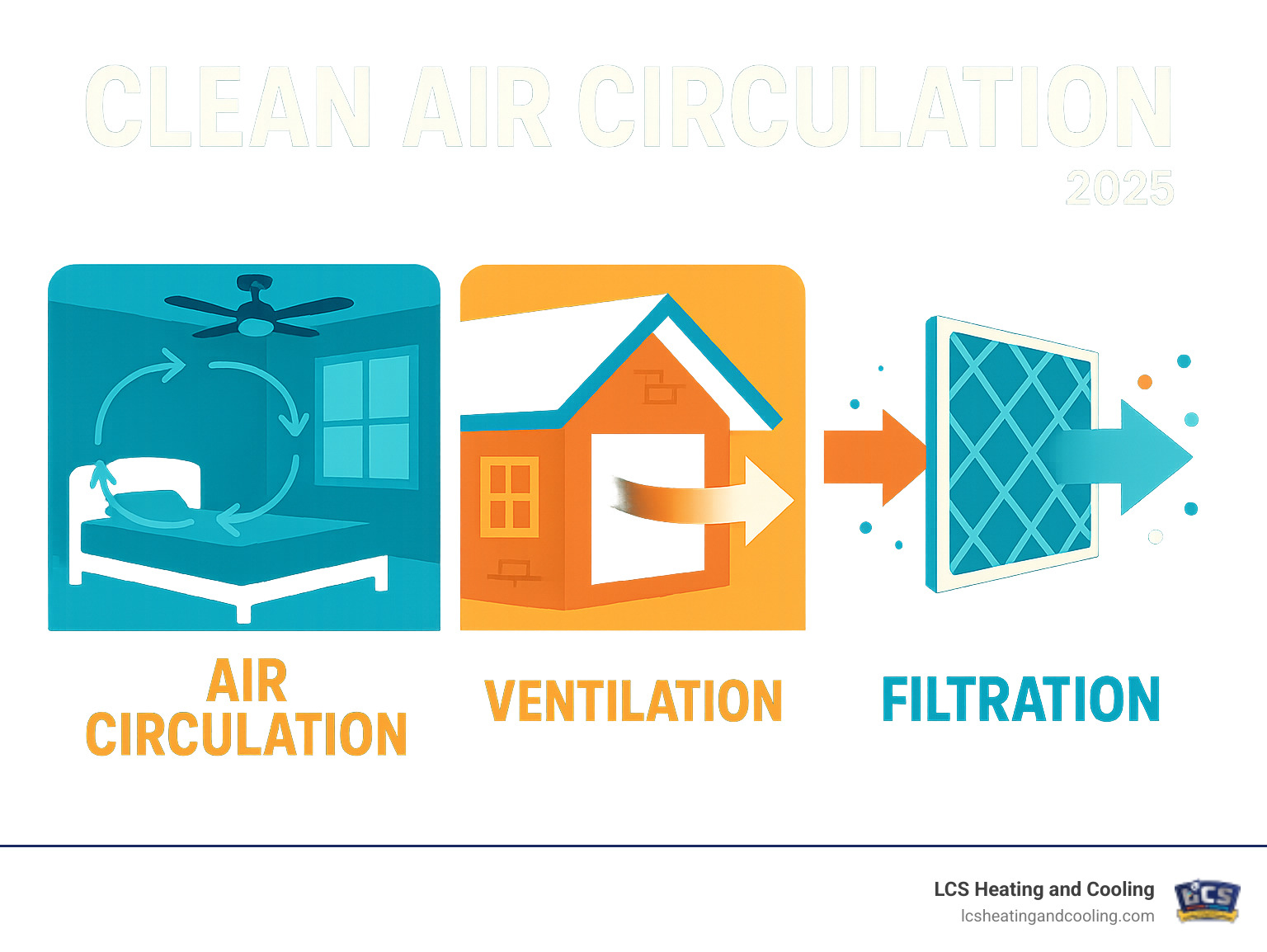
Clean air circulation vocabulary:
Why Good Air Circulation is Non-Negotiable
Think about the last time you walked into a stuffy room versus stepping outside on a breezy spring day. That difference you felt? That's the power of clean air circulation at work. Good airflow isn't just about comfort – it's absolutely essential for your health, your home's structural integrity, and your family's well-being.
The Health and Comfort Benefits
When air moves freely through your Indianapolis home, amazing things happen for your health. Improved respiratory health is the most obvious benefit – fresh, circulating air means you're constantly getting clean oxygen while stale, polluted air gets whisked away. It's like giving your lungs a breath of fresh air, literally.
But the benefits go much deeper than that. Good circulation dramatically reduces airborne illnesses by diluting and removing virus particles and bacteria before they can settle and multiply. Instead of germs lingering in corners and dead air zones, they get swept away and filtered out.
If you or anyone in your family deals with allergies or asthma, you'll notice the difference immediately. Allergy and asthma relief comes naturally when dust mites, pet dander, and pollen can't accumulate in stagnant pockets. These irritants get moved along instead of building up in your breathing space. Good air circulation becomes your invisible ally against respiratory triggers.
Temperature comfort gets a major boost too. No more walking from a freezing bedroom into a sweltering kitchen – consistent temperature throughout your home becomes the norm when air circulates properly. Your HVAC system can actually do its job instead of fighting against dead air zones.
Perhaps most surprisingly, many homeowners notice improved well-being and mental clarity. Stuffy air makes us feel sluggish and tired, while fresh, moving air helps us feel alert and energized. It's like the difference between working in a windowless basement and a bright, airy office.
The Dangers of Stagnant Air
On the flip side, stagnant air creates a perfect storm of problems that can seriously impact both your health and your home's condition. When air doesn't move, pollutant buildup becomes inevitable.
VOCs (Volatile Organic Compounds) from cleaning products, furniture, and everyday household items get trapped and concentrated. These invisible chemicals can cause headaches, eye irritation, and long-term health concerns when they have nowhere to go.
Meanwhile, dust mites throw parties in your still air, multiplying rapidly in undisturbed corners and fabric. Pet dander settles into carpets and upholstery instead of being filtered out. Even outdoor allergens that sneak inside get to stick around much longer than they should.
The moisture problem is where things get really serious. High humidity builds up when air can't move moisture away from bathrooms, kitchens, and even just from normal breathing and sweating. This excess moisture creates the perfect environment for mold and mildew growth.
Once mold takes hold, you're looking at potential structural damage to drywall, wooden framing, and flooring. What starts as a circulation problem can turn into thousands of dollars in repairs if left unchecked. The health impacts compound too – mold spores trigger respiratory problems and can cause serious reactions in sensitive individuals.
Understanding these risks makes it clear why residential ventilation rates affect respiratory health so significantly. The good news? Most circulation problems have straightforward solutions that don't require major renovations or huge expenses.
Simple Strategies for Better Airflow
The good news about achieving clean air circulation is that you don't need to break the bank or hire a contractor to see real improvements. Some of the most effective strategies are surprisingly straightforward and can make a noticeable difference in your home's air quality starting today.

Using Natural Ventilation
Mother Nature has been moving air around long before we invented HVAC systems, and we can tap into that power right in our homes. Natural ventilation is one of the oldest tricks in the book, and it's still one of the best.
The simplest approach is opening windows and doors strategically. But here's where it gets interesting – random window opening won't give you the best results. What you want to create is called cross-ventilation. Picture this: you open a window on one side of your room and another window (or door) on the opposite side. Fresh air flows in through one opening and carries stale air out through the other, creating a refreshing breeze that sweeps pollutants right out of your living space.
There's another natural phenomenon called the stack effect that's pure genius. Since warm air naturally rises, you can open windows on your lower level and higher-level windows (or even crack open an attic vent). The warm, stale air rises and exits through the upper openings, which pulls cooler, fresh air in through the lower ones. It's like turning your entire house into a natural chimney!
Of course, we need to be smart about outdoor air quality considerations. While outdoor air typically contains two to five times fewer pollutants than indoor air, there are definitely times when keeping those windows closed is the wiser choice. If you live near busy highways, industrial areas, or if there's wildfire smoke drifting through your neighborhood, you might be trading one air quality problem for another. High pollen counts can also make opening windows a misery for allergy sufferers. On days like these, it's better to keep windows sealed and let your HVAC system's filtration do the heavy lifting.
The Role of Fans in Promoting Clean Air Circulation
When natural breezes aren't cutting it, or when you need to direct airflow to specific areas, fans become your secret weapon for clean air circulation. They're affordable, energy-efficient, and surprisingly versatile.
Ceiling fans are workhorses that do more than just keep you cool. In summer, set them to spin counterclockwise to create that nice cooling downdraft. But here's a trick many people don't know: in winter, switch them to clockwise on a low speed. This gently pushes the warm air that's gathered near your ceiling back down where you can actually feel it, making your room more comfortable and helping your heating system work more efficiently.
Window fans are incredibly versatile little helpers. You can set them up to either pull fresh air in or push stale air out. For maximum effectiveness, try placing one securely in a window to exhaust room air outdoors. This creates negative pressure that naturally draws fresh outdoor air in through other open windows and doors throughout your home. Just be mindful not to blow potentially contaminated air directly from one family member to another.
Exhaust fans are absolute lifesavers in moisture-prone areas like bathrooms and kitchens. Running your bathroom exhaust fan during and for about 30 minutes after showering helps whisk away excess humidity before it can settle and create mold problems. Your kitchen exhaust fan (especially if it vents outdoors rather than just recirculating) is invaluable for removing cooking fumes, grease particles, and heat that would otherwise linger in your home.
Strategic fan placement can make or break your air circulation efforts. The key is creating pathways for air movement rather than just randomly placing fans around your home. Point fans toward open windows or doors to help facilitate air exchange, and make sure you're not blocking any vents or returns with furniture. The CDC offers excellent guidance on Improving Air Circulation with fans.
Addressing Stagnant Air Zones
Even homes with generally good air circulation can have stubborn stagnant areas – those sneaky pockets where air barely moves, allowing pollutants, dust, and dampness to accumulate. Think of them as little air traps hiding throughout your home.
Identifying stagnant areas is the first step to fixing them. These trouble spots typically lurk behind furniture that's pushed tight against walls, in room corners where air currents can't reach, inside closets and cupboards that rarely get opened, and in any heavily cluttered spaces where air simply can't flow freely.
Decluttering might not seem like an air quality strategy, but it's surprisingly powerful. Clutter acts like a maze that blocks airflow, forcing air to take longer, more complicated paths or stopping it altogether. By clearing excess items from floors and corners, you create open highways for air to travel. Even something as simple as regularly moving furniture slightly away from walls can help "stir up" the air in previously blocked zones.
One of the easiest wins is opening interior doors whenever possible. It sounds almost too simple, but keeping doors open allows air to flow freely between rooms instead of getting trapped in individual spaces. This helps your HVAC system distribute conditioned air more effectively throughout your entire home and prevents any one room from becoming a stagnant air pocket. For more comprehensive strategies on improving your home's air quality, check out More info about Indoor Air Quality.
Mastering Clean Air Circulation with Your HVAC System
Your home's heating and cooling system isn't just about temperature control—it's actually the most powerful tool you have for achieving consistent clean air circulation throughout your entire home. While opening windows and running fans are great, your HVAC system is what keeps the air moving even when outdoor conditions aren't cooperating.
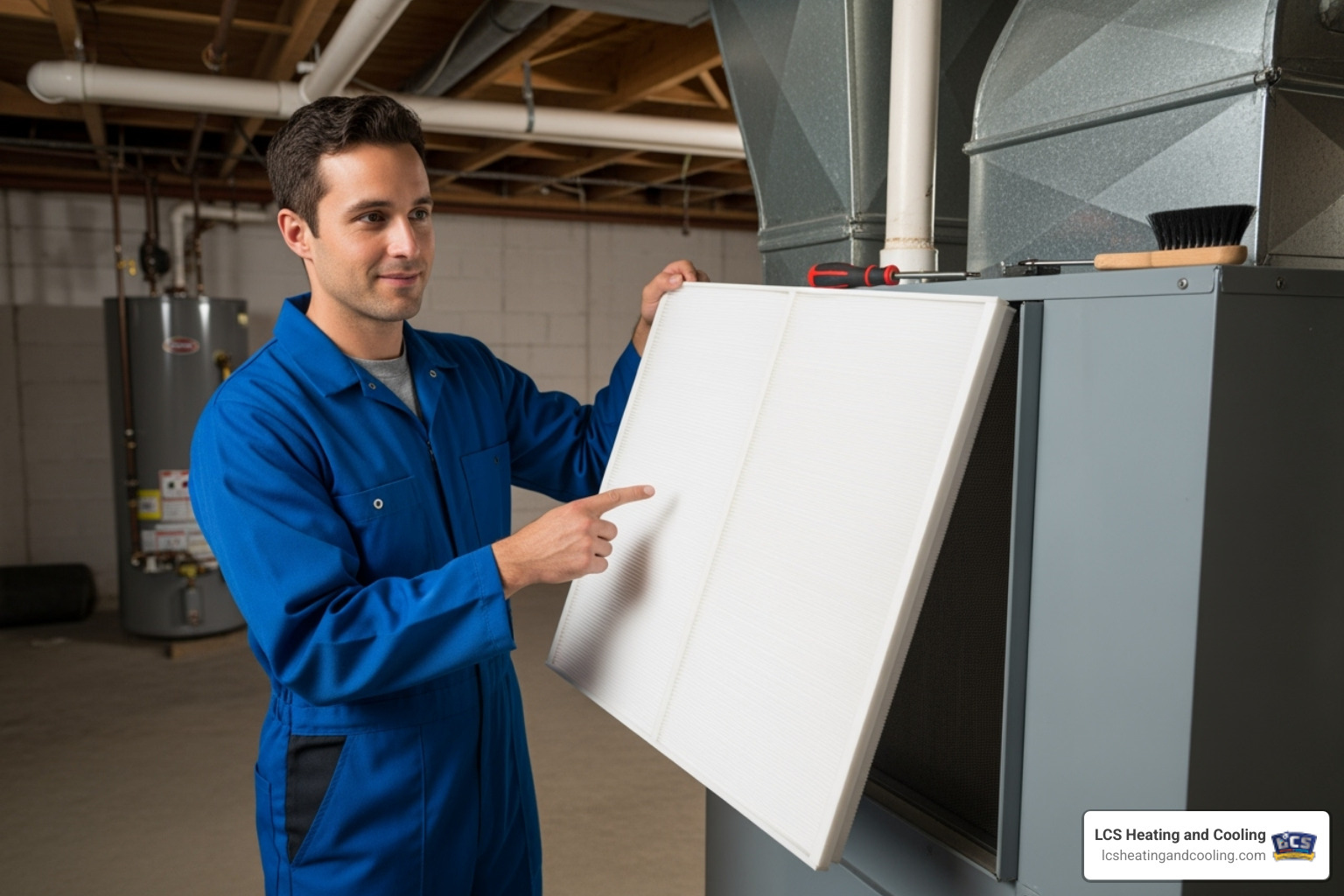
Your HVAC System: The Lungs of Your Home
Think about how your lungs work—they constantly draw air in, process it, and push it back out. Your HVAC system works the same way for your home. It pulls indoor air through return vents, conditions that air by heating or cooling it, then distributes it back through your ductwork to every room.
Here's something many Indianapolis homeowners don't realize: most forced air systems are designed primarily to circulate the air that's already inside your home, not necessarily to bring in fresh outdoor air. But that circulation is still incredibly valuable for maintaining good air quality.
The secret weapon in your HVAC system is the blower fan. Most people set their thermostat fan to "auto," which means it only runs when the system is actively heating or cooling. But here's a game-changer: try running the fan on "on" instead of "auto." This keeps air moving continuously throughout your home, even when you're not heating or cooling.
This constant air distribution helps eliminate those stuffy pockets where air gets trapped behind furniture or in corners. It also helps your home feel more comfortable by evening out temperature differences between rooms. You can learn more about how these systems create comfort in our guide to HVAC Systems in Household Comfort.
The Critical Role of Filtration and Maintenance
Your HVAC system can only provide clean air circulation if it's properly maintained. A neglected system can actually make your air quality worse by spreading dust and allergens around your home instead of removing them.
Your air filter is the unsung hero of clean air. It catches dust, pollen, pet dander, and other particles before they can circulate through your home or clog up your system's internal parts. We strongly recommend using pleated filters rather than those basic fiberglass ones. The pleated filters are much better at trapping tiny particles that can affect your health.
When shopping for filters, look for higher MERV ratings—MERV 13 filters are particularly effective at capturing smaller particles. But remember, a filter only works if it's clean and properly installed. Air will find a way around a dirty or poorly fitted filter, defeating the whole purpose.
Changing air filters regularly is probably the single most important thing you can do for air circulation. A clogged filter is like trying to breathe through a pillow—it restricts airflow and forces your system to work much harder. This not only reduces air circulation but can also lead to higher energy bills and system breakdowns. We've written extensively about this in Will Replacing Air Filters Improve Indoor Air Quality?.
Don't forget about your clogged vents either. Walk around your home and make sure furniture, curtains, or decorations aren't blocking your supply or return vents. Even partially blocked vents can significantly reduce airflow to that area.
Your ductwork integrity matters too. Leaky ducts are like having holes in your lungs—conditioned air escapes before it reaches your living spaces, reducing overall circulation. Professional maintenance, like the inspections we discuss in The Importance of Fall Furnace Inspections, can identify these issues before they become major problems.
Advanced Strategies for Clean Air Circulation
Ready to take your indoor air quality to the next level? There are some advanced strategies that can work alongside your existing HVAC system to create truly exceptional clean air circulation.
Understanding your home's air exchange rate (ACH) is a great starting point. This measures how many times per hour your home's air is completely replaced with outdoor air. ASHRAE recommendations suggest at least 0.35 air changes per hour for healthy indoor air quality. Most homes fall short of this without some intentional effort.
Air purifiers can be incredibly effective additions to your air circulation strategy. Portable units with HEPA filters can capture up to 99.97% of airborne particles, including dust, pollen, and even some bacteria and viruses. When choosing an air purifier, make sure it's sized appropriately for your room by checking its Clean Air Delivery Rate (CADR). The EPA's Guide to Air Cleaners in the Home provides excellent guidance on selecting the right unit.
For the ultimate in clean air circulation, consider whole-house ventilation systems. These systems mechanically bring in fresh outdoor air while exhausting stale indoor air, and they do it efficiently. Heat Recovery Ventilators (HRVs) and Energy Recovery Ventilators (ERVs) can even recover heat or coolness from the outgoing air to condition the incoming air, saving energy while improving air quality. The Department of Energy's Energy Saver: Whole-House Ventilation guide explains these systems in detail.
These advanced systems work beautifully with your existing HVAC system to create a comprehensive approach to indoor air quality. They're especially valuable in today's well-insulated homes, where natural air exchange is limited.
Frequently Asked Questions about Home Air Circulation
We get these questions all the time from Indianapolis homeowners who want to breathe easier at home. Let's explore the answers that can make a real difference in your indoor air quality.
How often should I change my HVAC air filter for optimal circulation?
Here's the truth: that "every three months" rule you've heard? It's just a starting point. Your home is unique, and your filter needs might be too.
Filter type plays a huge role in timing. Those high-MERV filters we love for their superior particle-catching abilities can sometimes fill up faster because they're doing such a thorough job. It's like having a really good net – it catches more, but it also gets full quicker.
Your home environment is another big factor. Living near construction sites, busy roads, or dealing with our notorious Indianapolis pollen seasons? Your filter is working overtime. And don't get me started on cottonwood season – that fluffy white stuff can turn a fresh filter into a clogged mess in just weeks!
Pets are adorable filter-killers. One cat or dog might mean changing filters every two months. Multiple pets? You might be looking at monthly changes. All that dander and fur has to go somewhere, and your filter is doing the heavy lifting.
If anyone in your household deals with allergies or asthma, more frequent changes aren't just helpful – they're essential. Monthly filter swaps can dramatically reduce symptoms by keeping those airborne irritants at bay.
Here's a simple test: hold your filter up to a light source. Can't see light through it? Time for a new one. Your HVAC system shouldn't have to struggle to push air through a clogged filter. For more detailed guidance, check out our HVAC Filter Change tips.
Can cleaning my air ducts really improve air circulation?
Absolutely! While you don't need duct cleaning every year like clockwork, it can be a game-changer for clean air circulation, especially if your ducts haven't seen professional attention in years.
Think about it this way: your ducts are like the highways of your home's air system. Over time, they collect dust, debris, pet hair, and sometimes even mold. This buildup doesn't just sit there looking unsightly – it actively fights against good airflow.
When your ducts are packed with debris, your HVAC system has to work much harder to push air through those narrowed passages. It's like trying to breathe through a stuffy nose – possible, but not pleasant or efficient. This debris buildup creates resistance that reduces the volume of conditioned air reaching your rooms, leading to those frustrating hot and cold spots.
Contaminant removal is another major benefit. Every time your system runs, it can recirculate dust, allergens, and other particles that have settled in dirty ducts. Professional cleaning eliminates this source of indoor pollution, giving you cleaner air and better system efficiency.
The difference can be remarkable – better airflow, more even temperatures, and air that just feels fresher. Our comprehensive Air Conditioning Ducts Complete Guide covers everything you need to know about keeping your ductwork in top shape.
When should I call a professional for air circulation problems?
Sometimes DIY solutions just aren't enough, and that's perfectly okay! We're here to help when things get complicated. You'll know it's time to call in the experts when certain red flags start waving.
Persistent odors that won't budge are a big warning sign. If you've cleaned, aired out your home, and changed filters, but strange smells keep coming back, there might be hidden mold in your ducts or trapped pollutants that need professional attention.
Uneven temperatures throughout your home can drive you crazy. You've tried fans, opened doors, adjusted vents, but some rooms still feel like saunas while others are arctic tundras. This usually points to ductwork issues, system sizing problems, or airflow imbalances that require professional diagnosis.
Visible mold growth or consistently high humidity levels (above 50%) are serious concerns. While you can handle minor surface mold, widespread growth or that persistently clammy feeling suggests ventilation or moisture control issues that need expert intervention.
Unexplained allergy symptoms that seem worse indoors are particularly frustrating. You've done everything right – new filters, regular cleaning, good housekeeping – but family members are still sneezing, coughing, and dealing with itchy eyes. Professional indoor air quality testing can identify hidden culprits you might never find on your own.
Finally, if you've tried all our simple strategies and you're still not seeing improvement, it's time to call in reinforcements. Sometimes the issue is complex – leaky ducts, improperly sized equipment, or ventilation deficiencies that only trained technicians can spot and fix. That's what we're here for!
Breathe Easier with Professional Support
Creating a home filled with clean air circulation isn't just about following a checklist – it's about building a foundation for your family's health and comfort that lasts for years to come. Throughout this guide, we've walked together through the essentials, from understanding why air movement matters to implementing practical solutions that make a real difference in your Indianapolis home.
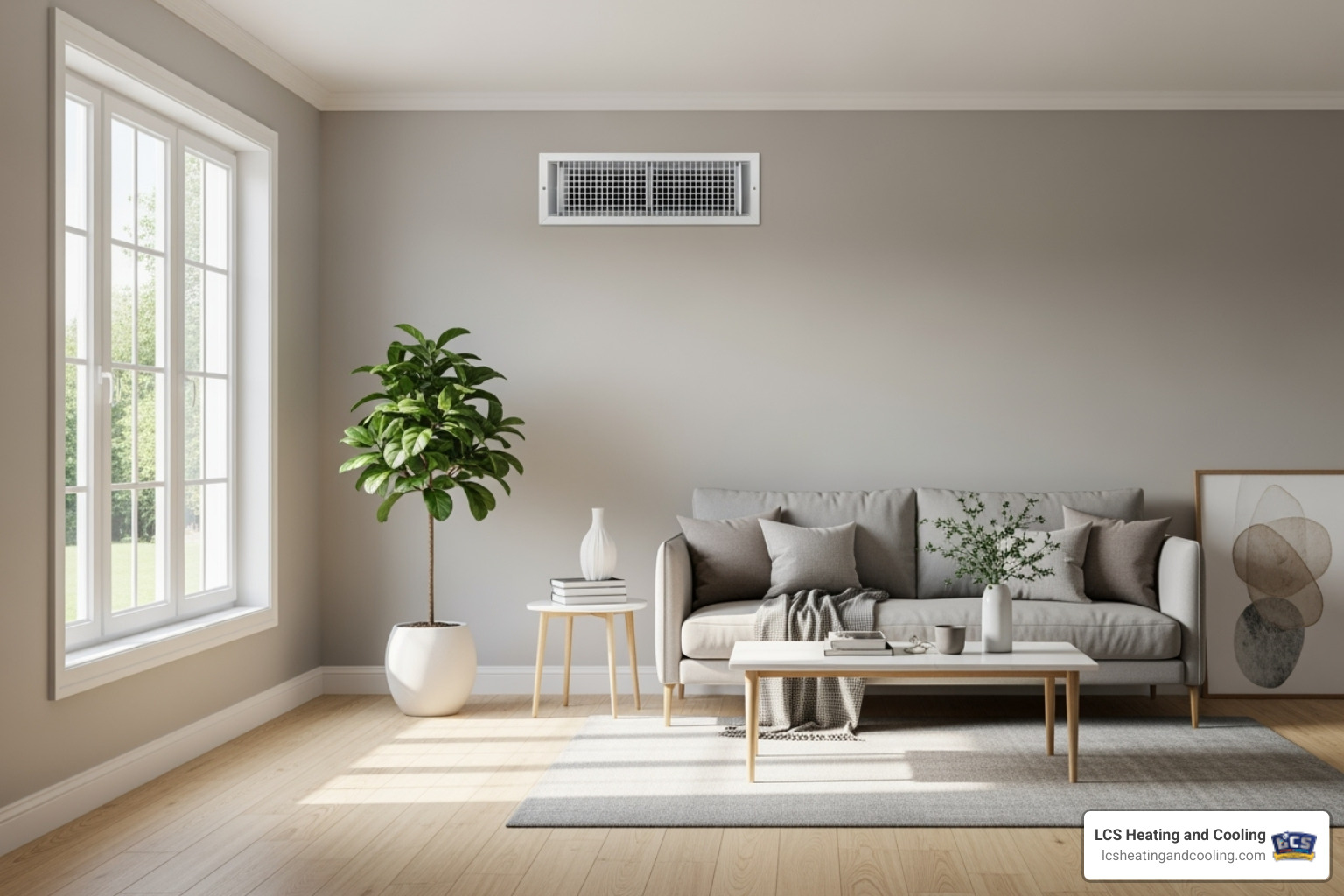
The journey to better indoor air quality starts with recognizing that clean air circulation truly is the foundation of a healthy home. When we allow air to move freely, we're actively protecting our families from the dangers of stagnant air – those invisible threats like pollutant buildup, allergen accumulation, and excess humidity that can lead to mold growth and structural damage.
The beauty of improving air circulation lies in how accessible many solutions are. Simple strategies like opening windows for cross-ventilation, using fans strategically, and keeping interior doors open can transform your home's air quality almost immediately. Even something as basic as decluttering can eliminate those stagnant air zones where problems love to hide.
Your HVAC system serves as the lungs of your home, working tirelessly to distribute conditioned air throughout every room. But like our own lungs, it needs proper care to function at its best. Regular filter changes using quality pleated filters, maintaining clear vents, and ensuring your ductwork integrity all play crucial roles in maintaining optimal airflow.
Proactive maintenance is where the magic really happens. Think of it as preventive medicine for your home. When you stay on top of filter changes, schedule regular HVAC inspections, and address small issues before they become big problems, you're investing in your family's long-term health and comfort. It's so much easier to maintain good air quality than to fix problems after they've taken hold.
At LCS Heating and Cooling, we understand that every home is unique, and sometimes DIY solutions need professional backup. Our 7-Star Concierge Service means we're here to support you with prompt, clear communication and streamlined processes. Whether you're dealing with persistent odors, uneven temperatures, or just want to ensure your system is performing at its peak, we're committed to keeping you informed and comfortable every step of the way.
When you're ready to take your home's air quality to the next level, we're proud to serve Indianapolis, Carmel, Fishers, Lawrence, Noblesville, and Zionsville with comprehensive HVAC services. From routine maintenance to Schedule professional duct cleaning in Indianapolis, we're here to help you create the healthy, comfortable home your family deserves.
Your journey to better clean air circulation doesn't end here – it's an ongoing commitment to your family's well-being. With the right knowledge, consistent maintenance, and professional support when you need it, you can breathe easier knowing your home is working as hard as you are to keep everyone healthy and comfortable.
